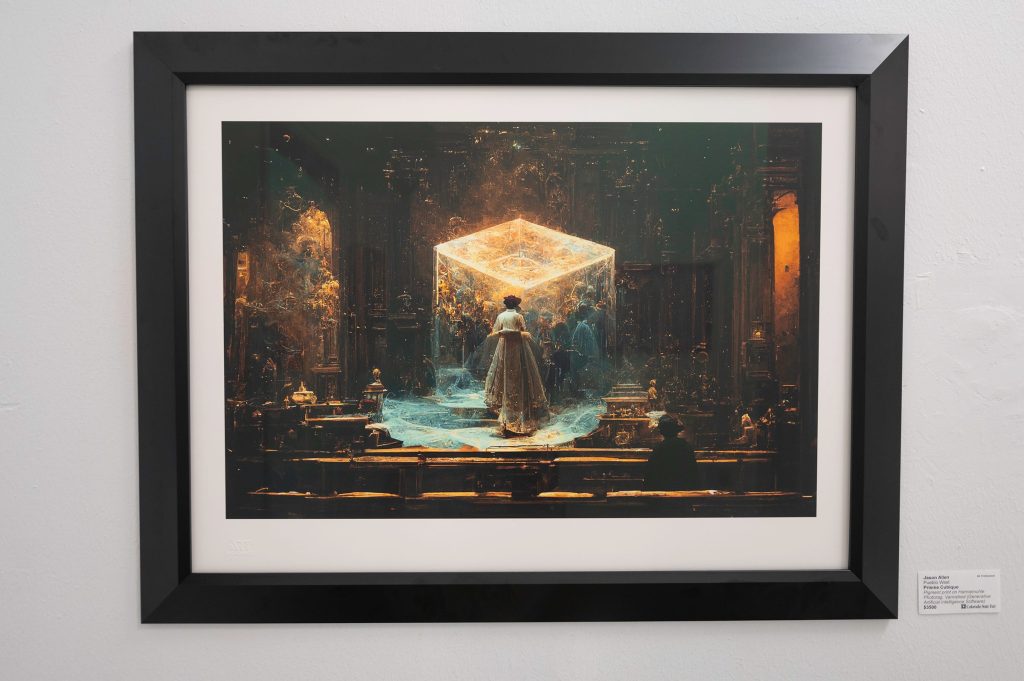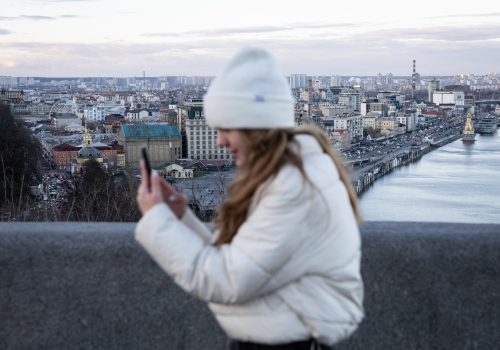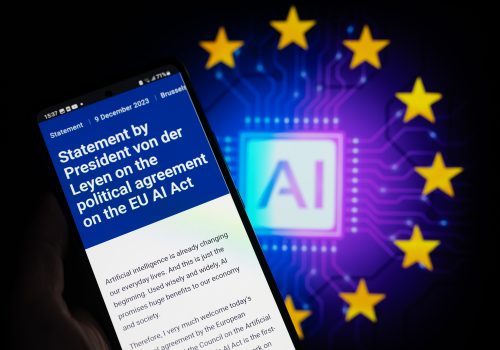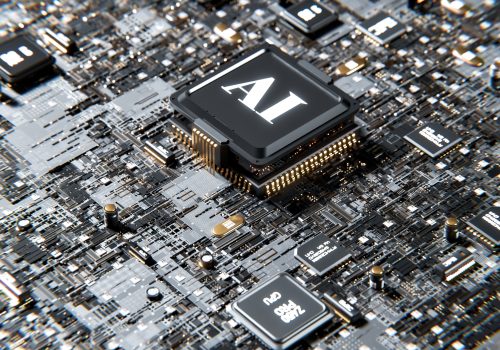As generative artificial intelligence (AI) tools such as DALL-E, MidJourney, and Stable Diffusion accumulate millions of registered users, the tools’ image-creation abilities have sparked waves of criticism. Some critics point to the use of AI to generate illegal and nonconsensual images. Others speak about theft of intellectual property, suggesting a kind of “automated plagiarism.” Image generators are trained on hundreds of thousands of images made by human creators. The Biden administration and the Group of Seven (G7) both affirm copyright protection as a fundamental requirement for trustworthy AI, but what this would mean for an artist whose work has been “stolen” to train these models remains murky at best.
The evolving landscape of generative AI reveals shortcomings in current copyright regulations, including outdated notions of intellectual property and compensation as well as undue burdens on creators. The solution needs to be rooted in collective negotiation and international consensus.
Brushstrokes and pixels
What is art? Plato held that art is imitation. Indian philosopher Bharata described rasa (flavor) in art. In contemporary philosophy, there are numerous aesthetic definitions, which define qualities inherent to the art, as well as disjunctive definitions, such as where art is a product of the aesthetic of its time or is part of a recognized tradition or institution. In other words, there is no one definition of art, leading some proponents of AI art to argue that anything we deem to be art becomes art.
However, can something be art if there is no artist? Critics and proponents of AI art agree on one thing—there needs to be a human holding the brush. As computer scientist Joseph Weizenbaum famously wrote in 1976: “No other organism, and certainly no computer, can be made to confront genuine human problems in human terms.” Last year an AI-generated entry won the Colorado state fair’s fine arts competition in the “digitally manipulated art” category. The winner, who had never dabbled in art before the advent of generative AI, said that AI “is a tool, just like the paintbrush is a tool. Without the person, there is no creative force.”
Neurons and code
The principles published by the G7 after its May 2023 meeting in Hiroshima began with this preface: “Different jurisdictions may take their own unique approaches to implementing these actions in different ways.” Indeed, countries’ approaches to the emerging question of “authorship” where human beings are not necessarily involved fall along a bewildering spectrum. The US Copyright Office only grants copyright to “works created by human beings.” Famously, in the 2018 case of a selfie taken by a crested macaque named Naruto using the camera of photographer David Slater, a US court declared that non-humans do not have statutory standing under the Copyright Act. However, according to the Copyright Office, works created through text prompts and lacking any further creative input by the human user, as in the case of generative AI tools, would not be copyrightable because “these prompts function more like instructions to a commissioned artist.”
China’s draft rules on generative AI, released in April, require that these services and products respect intellectual property rights, both at a commercial and personal level. The wording is broad—perhaps excessively so. It requires generative AI service providers to ensure their models meet legal requirements and would likely require a new licensing architecture for data mining. Chinese copyright law recognizes individuals and organizations (leaning heavily toward companies), but not “entities” like AI models, as copyright holders. It recognizes the rights of adaptation and compilation—the right to transform a work and arrange existing ones—but also requires publishers of such adapted work to compensate the authors of the original. As in the US case, this approach leaves some gray area for generative AI systems, depending on whether a generated work is viewed as an adaptation with sufficient original input. Interestingly, in 2020, a Shenzhen court ruled that an AI-generated news article qualified for copyright protection, as it met the threshold for originality.
According to India’s Copyright Act, the “author” of a copyrightable work is, “in relation to any literary, dramatic, musical or artistic work which is computer-generated, the person who causes the work to be created.” According to a July 2023 report by New Delhi law firm Ikigai Law, “In India, a work must involve a minimum degree of creativity and not be a product of only skill and labor. Output produced by AI tools may not satisfy the requirement of ‘creativity’ required for copyright protection, if they are viewed as a collection of data compiled from already existing sources without any infusion of creativity.” In this sense, Indian and US copyright law agree that a certain class of AI-generated works would not qualify for copyright.
Japan is tackling the gray area generated by foundational models as well. In July and September, the Japanese Agency for Cultural Affairs convened panels to deliberate the required threshold for “creative contributions” of human authors. At the same time, the government has stated that Japanese copyright will not protect holders/creators of data used for AI training.
All these regulatory measures are grappling with the fact that, counterintuitively, generative AI is not always a “tool,” and there can be cases where the AI is doing most of the creative “labor,” albeit by drawing upon the creative output of hundreds of thousands of human artists. On top of that, the sheer size of datasets used to train image generators makes it difficult for individuals to prove copyright infringement (not to mention that many artists who post their work online do not register copyright). In a recent federal court ruling in California, the presiding judge dismissed a class action lawsuit by three artists against DeviantArt, an online art community, and MidJourney. The ruling stated that it would be impossible for the defendants to audit every single image in the database for potential copyright infringement (complicated by the fact that the database in question, LAION, is open-source), and it is difficult for an artist to prove a generated image is derived from their work, absent “substantial similarity.”
Unregulatable AI?
Generative AI is certainly unlike any paintbrush humans have used before. It is only as “creative” as the artists whose works were fed into the model, but also, as some countries’ positions imply, reflects the creative vision of the person who uses it.
Scrolling through the nearly ten thousand public comments received by the Copyright Office as part of its AI study (a task for which an AI assistant would have been welcome), the common themes that emerge are consent and compensation. As one commenter states: “As an artist, I never gave permission for AI to regurgitate my work. I was never asked if it would be all right with me.”
What further complicates copyright is that these laws are national in scope, whereas datasets are not. And as the analysis above has shown, different jurisdictions are approaching this issue in divergent ways (if they are at all). Therefore, it is wholly possible that if certain countries impose rules that are seen as harsh by companies, they can relocate their operations to safer havens.
Copyright collectives or copyright societies offer one potential lifeline for artists. This has been a model for collective negotiation of multiple works, where the collective negotiates copyright and compensation on behalf of a group. However, in the internet age, such collectives would need to be international in scope, or part of a network of collectives. They would also need to lower their membership fees, which many artists—who publish their works online in good faith and with no expectation of remuneration—would not be able to afford.
Another potential pathway is the Berne Convention for the Protection of Literary and Artistic Works, which 181 countries have signed onto. While the convention is limited by the copyright laws of the nations that are party to it, it can serve as a forum for countries to agree to a baseline set of protections for artists with regard to companies building generative AI models.
As generative AI becomes more advanced and widely accessible, and is applied in unexpected ways, it has become quite evident that current copyright law—which often places undue onus on those whose work is being used without their consent—offers inadequate solutions. Any tenable resolution to the challenge posed by generative AI to copyright would need collective bargaining and international buy-in.
Trisha Ray is an associate director and resident fellow at the Atlantic Council’s GeoTech Center.
Further reading
Tue, Dec 12, 2023
Ukraine’s AI road map seeks to balance innovation and security
UkraineAlert By
As the world grapples with the implications of rapidly evolving Artificial Intelligence (AI) technologies, Ukraine has recently presented a national road map for AI regulation that seeks to balance the core values of innovation and security, writes Ukraine's Minister for Digital Transformation Mykhailo Fedorov.
Mon, Dec 11, 2023
Experts react: The EU made a deal on AI rules. But can regulators move at the speed of tech?
New Atlanticist By
EU policymakers reached a deal on Europe’s first comprehensive artificial intelligence rules. Atlantic Council experts share their insights on the breakthrough.
Thu, Nov 16, 2023
AI governance on a global stage: Key themes from the biggest week in AI policy
GeoTech Cues By Courtney Lang
The week of October 30, 2023 was a monumental week for artificial intelligence (AI) policy globally. As a quick recap: In the United States, one of the longest Executive Orders (EO) in history was signed by President Biden, aimed at harnessing the opportunities of AI while also seeking to address potential risks that may be […]
Image: Pueblo West resident Jason Allen's AI-generated art piece titled, "Prisme Cubique", on display at the Colorado State Fair on Friday, September 1, 2023.



